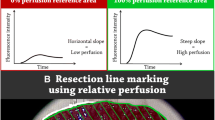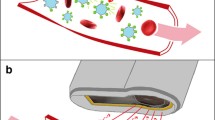Abstract
Background
Indocyanine green fluorescence imaging (ICG-FI) can be used to evaluate intestinal perfusion prior to anastomosis. Several software for the quantification of fluorescence have emerged, but these have not previously been compared. The aim of this study was to compare the results from quantitative ICG-FI analysis of relative perfusion in an experimental setting using two different software-based quantification algorithms (FLER and Q-ICG).
Methods
Twenty pigs received a laparotomy, and ischemic areas were created in three segments of the small intestine of each pig. For each ischemic area, fluorescence imaging was performed and the fluorescence recordings were quantitatively analyzed using FLER and Q-ICG. The quantitative analysis resulted in a set of perfusion lines for each software for either 30%, 60% or 100% relative perfusion. The perfusion lines were compared by registering the normalized slope for each set of perfusion lines, calculating the relative perfusion percentage in the FLER perfusion line according to Q-ICG, and measuring the length of the ischemic area for each analysis.
Results
Fifty-four fluorescence recordings from 18 pigs were included. The ischemic segment for FLER was significantly longer in the 30% perfusion group and significantly shorter in the 100% perfusion group as compared to Q-ICG. The normalized slope for the FLER perfusion lines was significantly higher in the 30% perfusion group and significantly lower in the 100% perfusion group as compared to the Q-ICG perfusion lines. For the perfusion lines defined by FLER as 30%, 60%, and 100%, Q-ICG found 35.2% (p = 0.07), 63.7% (p = 0.31), and 84.1% perfusion (p = 0.003) respectively.
Conclusion
The two software demonstrated significant differences in quantitative fluorescence analysis when perfusion was either very high or very low. The clinical relevance of these differences is unclear.




Similar content being viewed by others
References
Chadi SA, Fingerhut A, Berho M, DeMeester SR, Fleshman JW, Hyman NH, Margolin DA, Martz JE, McLemore EC, Molena D, Newman MI, Rafferty JF, Safar B, Senagore AJ, Zmora O, Wexner SD (2016) Emerging trends in the etiology, prevention, and treatment of gastrointestinal anastomotic leakage. J gastrointestsurg: off j Soc SurgAlim Tract 20:2035–2051
Reinhart MB, Huntington CR, Blair LJ, Heniford BT, Augenstein VA (2016) Indocyanine green: historical context, current applications, and future considerations. Surginnov 23:166–175
Degett TH, Andersen HS, Gogenur I (2016) Indocyanine green fluorescence angiography for intraoperative assessment of gastrointestinal anastomotic perfusion: a systematic review of clinical trials. Langenbeck's arch surg 401:767–775
van den Bos J, Al-Taher M, Schols RM, van Kuijk S, Bouvy ND, Stassen LPS (2018) Near-infrared fluorescence imaging for real-time intraoperative guidance in anastomotic colorectal surgery: a systematic review of literature. J laparoendoscopic adv surg tech A 28:157–167
Wada T, Kawada K, Takahashi R, Yoshitomi M, Hida K, Hasegawa S, Sakai Y (2017) ICG fluorescence imaging for quantitative evaluation of colonic perfusion in laparoscopic colorectal surgery. SurgEndosc 31:4184–4193
Nerup N, Andersen HS, Ambrus R, Strandby RB, Svendsen MBS, Madsen MH, Svendsen LB, Achiam MP (2017) Quantification of fluorescence angiography in a porcine model. Langenbeck's arch surg 402:655–662
Diana M, Agnus V, Halvax P, Liu YY, Dallemagne B, Schlagowski AI, Geny B, Diemunsch P, Lindner V, Marescaux J (2015) Intraoperative fluorescence-based enhanced reality laparoscopic real-time imaging to assess bowel perfusion at the anastomotic site in an experimental model. Br J Surg 102:e169–176
Diana M, Halvax P, Dallemagne B, Nagao Y, Diemunsch P, Charles AL, Agnus V, Soler L, Demartines N, Lindner V, Geny B, Marescaux J (2014) Real-time navigation by fluorescence-based enhanced reality for precise estimation of future anastomotic site in digestive surgery. SurgEndosc 28:3108–3118
Diana M, Noll E, Diemunsch P, Dallemagne B, Benahmed MA, Agnus V, Soler L, Barry B, Namer IJ, Demartines N, Charles AL, Geny B, Marescaux J (2014) Enhanced-reality video fluorescence: a real-time assessment of intestinal viability. Ann Surg 259:700–707
Nerup N, Ring LL, Strandby RB, Egeland C, Svendsen MBS, Hasselby JP, Willemoe GL, Hartmann B, Svendsen LB, Achiam MP (2018) Quantitative perfusion assessment of intestinal anastomoses in pigs treated with glucagon-like peptide 2. Langenbeck's arch surg 403:881–889
Nerup N, Svendsen MBS, Svendsen LB, Achiam MP (2020) Feasibility and usability of real-time intraoperative quantitative fluorescent-guided perfusion assessment during resection of gastroesophageal junction cancer. Langenbeck's arch surg 405:215–222
Ronn JH, Nerup N, Strandby RB, Svendsen MBS, Ambrus R, Svendsen LB, Achiam MP (2019) Laser speckle contrast imaging and quantitative fluorescence angiography for perfusion assessment. Langenbeck's arch surg 404:505–515
Nerup N, Knudsen KBK, Ambrus R, Svendsen MBS, Thymann T, Ifaoui IBR, Svendsen LB, Achiam MP (2017) Reproducibility and reliability of repeated quantitative fluorescence angiography. Surgtechnolint 31:35–39
Seeliger B, Agnus V, Mascagni P, Barberio M, Longo F, Lapergola A, Mutter D, Klymchenko AS, Chand M, Marescaux J, Diana M (2019) Simultaneous computer-assisted assessment of mucosal and serosal perfusion in a model of segmental colonic ischemia. Surgendosc. https://doi.org/10.1007/s00464-019-07258-z
Barberio M, Felli E, Seyller E, Longo F, Chand M, Gockel I, Geny B, Swanstrom L, Marescaux J, Agnus V, Diana M (2020) Quantitative fluorescence angiography versus hyperspectral imaging to assess bowel ischemia: a comparative study in enhanced reality. Surgery. 168:178–184
Diana M, Dallemagne B, Chung H, Nagao Y, Halvax P, Agnus V, Soler L, Lindner V, Demartines N, Diemunsch P, Geny B, Swanstrom L, Marescaux J (2014) Probe-based confocal laser endomicroscopy and fluorescence-based enhanced reality for real-time assessment of intestinal microcirculation in a porcine model of sigmoid ischemia. SurgEndosc 28:3224–3233
Kilkenny C, Browne WJ, Cuthill IC, Emerson M, Altman DG (2010) Improving bioscience research reporting: the arrive guidelines for reporting animal research. PLoSBiol 8:e1000412
Gosvig K, Jensen SS, Qvist N, Agnus V, Jensen TS, Lindner V, Marescaux J, Diana M, Ellebaek MB (2019) Remote computer-assisted analysis of ICG fluorescence signal for evaluation of small intestinal anastomotic perfusion: a blinded, randomized, experimental trial. SurgEndosc 34:2095–2102
Acknowledgements
The authors are grateful to Guy Temporal for proofreading the manuscript.
Funding
This work was supported by the ARC Foundation for cancer research (ELIOS project, www.fondation-arc.org) and the Odense University Hospital Free Research Fund (Grant No. 34-A1806). The funding sources had no involvement in study design; in the collection, analysis and interpretation of data; in the writing of the report; or in the decision to submit the article for publication.
Author information
Authors and Affiliations
Corresponding author
Ethics declarations
Disclosures
Michele Diana is a member of the Advisory Board of Diagnostic Green. Drs. Kristina Gosvig, Signe Steenstrup Jensen, Niels Qvist, Nikolaj Nerup, Vincent Agnus, and Mark Bremholm Ellebæk have no conflicts of interest or financial ties to disclose.
Additional information
Publisher's Note
Springer Nature remains neutral with regard to jurisdictional claims in published maps and institutional affiliations.
Rights and permissions
About this article
Cite this article
Gosvig, K., Jensen, S.S., Qvist, N. et al. Quantification of ICG fluorescence for the evaluation of intestinal perfusion: comparison between two software-based algorithms for quantification. Surg Endosc 35, 5043–5050 (2021). https://doi.org/10.1007/s00464-020-07986-7
Received:
Accepted:
Published:
Issue Date:
DOI: https://doi.org/10.1007/s00464-020-07986-7




